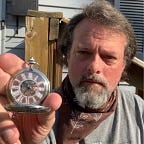The myth of Mad Men and graphic arts
Recently, someone posted up a question in Quora, asking what one does with an English Lit degree. It reminded me of this essay I wrote a while back. At that time, there was a narrative going on within the creative community lamenting the demise of professional graphic artists. One such narrative appears on my favorite design blog, Before&After Magazine.
Inevitably, someone brings up Mad Men as an example of the glory days of advertising.
And I sigh deeply.
Firstly, let’s get one thing perfectly clear. Don Draper is a fictional character, partially based on Draper Daniels, the creative head of the Chicago-based Leo Burnett advertising agency in the ’50s. Matt Weiner can write him to do anything and say anything. He did not exist. He does not exist. Never. Ever, ever, ever.
Don’s story for us starts in medias res as a successful creative director banging out copy in a bar in New York City. As the story unfolds over the next four seasons, we find out he was a poor kid growing up on a farm “somewhere in the Midwest,” joined the Army to get the heck off the farm, sold used cars in California, never went to college, never wrote anything longer than 250 words, moved to New York City and sold furs and did copywriting/advertising on the side for the owner (who probably never would have hired a graphic artist if Don didn’t do the work) and eventually grifted his way into Sterling-Cooper.
Don’s path is hardly the one you most read about. Most professional graphic artists have a BFA or certificate from an art school. They trained to eventually become creative/art directors in agencies, living the Don Draper Dream.
But if you look closely, the credentialed people who work at Sterling-Cooper and later Sterling-Cooper-Draper-Price are the first ones getting fired when an account is lost. Don prevails and gets stronger despite not having the credentials of a “real” creative director. Sure, he has his moments of panic but who doesn’t? And Don’s panic is more understandable when he admits to himself he has been faking his entire adult life. Again, folks, he is not real so Weiner can write all these traits into the Don Draper character.
The problem with not believing Don Draper isn’t real is I know people like Don Draper. I know people in the graphic arts field who have no business being there because they don’t have the “proper” credentials*. Yet, they are the folks I turn to when I need something done.
How many agencies would hire a Don Draper if he was looking for work? Probably all of them. How many would hire a used-car salesman turned furrier who did advertising for them on the side without an art degree? None of them. The irony in all this is the latter is exactly what Sterling-Cooper did, albeit unknowingly.
Don was successful not so much because of his superior copywriting and creative ability, but in his willingness to learn and his keen observation of human behavior. He learned what made people tick and more importantly, how to make them tick to a rhythm he tapped out. He played Roger into his job and continues to play him. For Don, Roger is the perfect whetstone that sharpens his skills. But this is not a character analysis post. This is just a reminder that creative ability is not about art degrees. Creative people don’t hold any special rights to the keys of knowledge. But people who are willing to use the tools they have and sharpen that craft do.
Like the graphic arts industry, Mad Men could have easily just evaporated after season four. The most ardent fans among us would have had a momentary Don Draper panic moment, but then like Don, realized life goes in only one direction — forward. Instead of slinking home in the rain to a stiff drink and a pair of bedroom slippers, we would have sighed deeply, been grateful for the spectacular opportunity we had been given, looked bravely onto the horizon and enthusiastically asked:
“What’s next?”
Everyone in advertising wants to be Don Draper but few want to go through the pain of becoming Don. Fewer still want the anxiety of staying Don.
*I am, in fact, one of those posers. Read my story. Nowhere in there is any formal training in graphic design. Yet I fooled a lot of people into thinking I could do the job, mostly because I could.
Originally published my other blog on February 6, 2012.
